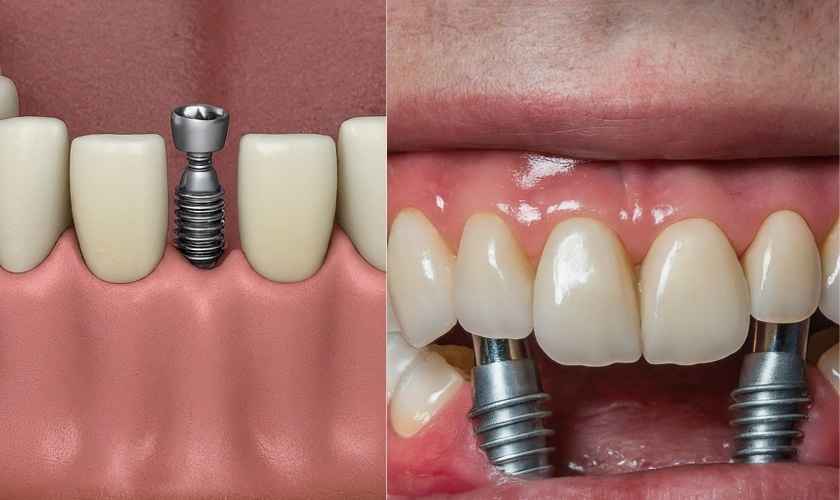Indicators on Dental Sense You Need To Know
Table of ContentsThe 10-Second Trick For Dental Sense6 Easy Facts About Dental Sense ExplainedAll About Dental SenseThe Greatest Guide To Dental Sense
are medical tools surgically dental implanted into the jaw to bring back a person's ability to chew or their look. They give support for synthetic (phony) teeth, such as crowns, bridges, or dentures. When a tooth is shed as a result of injury or condition, a person can experience problems such as quick bone loss, faulty speech, or adjustments to eating patterns that cause discomfort.Dental implant systems include a dental implant body and dental implant abutment and might also consist of an abutment fixation screw. Front tooth filling. The oral implant body is surgically placed in the jawbone instead of the tooth's root. The dental implant abutment is usually connected to the dental implant body by the joint fixation screw and extends via gum tissues right into the mouth to support the attached fabricated teeth
(https://www.easel.ly/browserEasel/14548839)Structure of The Dental Implant System picking oral implants, talk to your dental copyright concerning the potential benefits and threats, and whether you are a prospect for the procedure. Things to think about: Your general health and wellness is a crucial consider figuring out whether you are an excellent candidate for dental implants, the length of time it will take to heal, and just how long the implant may remain in area.
Cigarette smoking may affect the recovery procedure and reduce the long-lasting success of the dental implant. The recovery process for the dental implant body might take several months or longer, during which time you normally have a temporary abutment in location of the tooth. the dental implant procedure: Thoroughly follow the oral health guidelines offered to you by your oral service provider.
Some Known Details About Dental Sense
Implant failure can lead to the requirement for an additional procedure to take care of or replace the implant system. Brings back the capability to chew Recovers cosmetic appearance Assists keep the jawbone from diminishing because of bone loss Protects the wellness of the bordering bone and gums Helps maintain surrounding (nearby) teeth secure Enhances high quality of life Damage to bordering natural teeth during implant positioning Injury to the surrounding tissues throughout surgical procedure, such as sinus opening Injury during surgical treatment (as an example, fracture of surrounding jawbone) Insufficient feature, such as really feeling like the teeth do not attack with each other normally A feeling that the tooth hangs or turning in location resulting from a joint screw loosening Implant body failure (looseness of the implant body) due to systemic infection, which may be more probable in patients with uncontrolled diabetes because of regional infection in bone and gum tissues sustaining the implant body because of postponed recovery, which may be most likely in patients who smoke Trouble cleaning the gums around the implant, causing inadequate oral health Neglected periodontal disease Post-surgical pins and needles because of nerve impingement or damages Always inform health care suppliers and imaging service technicians that you have oral implants prior to any kind of magnetic vibration imaging (MRI) or x-ray procedures.
FDA is not knowledgeable about any type of negative occasions reported for MRI or x-ray procedures with oral implants. Dental implants systems are typically constructed from products that comply with worldwide agreement standards of the International Organization for Standardization (ISO) or ASTM International. These criteria have information of what makes a safe product.

A dental implant is a framework that changes a missing tooth. With screw-like tools, the surgeon inserts a dental implant right into the jawbone, and it acts as a support for a synthetic tooth, called a crown.
What Does Dental Sense Do?
Some people are not eligible for oral implant surgical procedure. It is for oral specialists to check out this site run on individuals with: severe illnessuncontrollable metabolic diseasebone or soft tissue disease or infectionIf these concerns are solved, an individual can have the surgical treatment. In, dental specialists refrain from operating on individuals with: If individuals with any one of the above go through dental implant surgical procedure, there is a higher threat of the implant falling short.

Oral implant surgical treatment is a customized process. Provide you time to recover. Affix the message and final crown, bridge or denture.
Next, your doctor will thoroughly put the dental implant into your jaw. Ultimately, your doctor will rearrange your gum tissues and close the incision with stitches. If your dental implant is near the front of your mouth, your dentist will certainly make a short-term tooth for you to use up until you recover. This way, you will not have a gap in your smile while you recover.
Little Known Facts About Dental Sense.
Throughout the healing stage, your jawbone must fuse to the dental implant. This procedure can take anywhere from three to nine months.
Once your implant heals, your dentist can attach the joint (little adapter message) and your final reconstruction (crown, bridge or denture). This usually takes concerning one hour to complete and may call for a second minor surgery. You should not feel any kind of pain during your oral implant procedure since your service provider will certainly use drug to numb your periodontals.